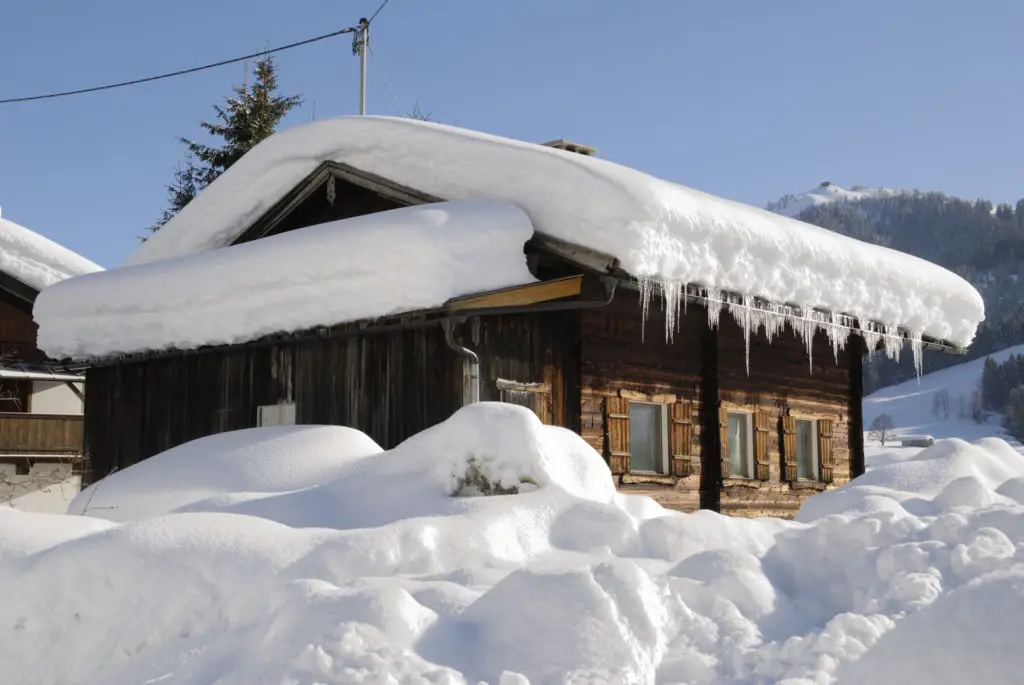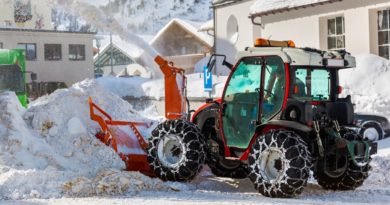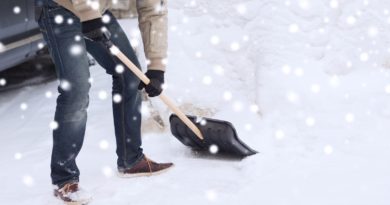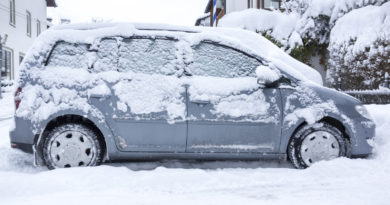How to Remove Snow From Your Roof
**Articles may contain links that I earn compensation for if clicked and you make a purchase. As an Amazon Associate, I earn from qualifying purchases. These earnings do not actually impact the price of the product or service.
Do you live in a region that has snow? If so, you know how much of a pain it can be to remove the snow from the roof. It seems like no matter what products or methods are used, and there’s always an issue with either time or cost.
So, what is one supposed to do when they don’t have enough idea for it, and their patience starts running low? Well, luckily for all of us who have been wondering this question for years now, we have finally put together helpful information in this guide that can help all of us out there!
Let’s get to it!
Table of Contents
When Should You Take Snow off Your Roof?
It’s essential to remove the snow from your roof, or at least get it off of there as soon as possible. This is because if people don’t do something about the weight of the snow on their roofs, they’re going to have a lot of problems later on.
Following are some tell-tale signs that indicate you need to take the snow off your roof:
Dropping-Cracking Noise
When there is a lot of weight on the roof for too long without any support, it can cause the roof to bend and crack, affecting its durability.
You Have a Low-Pitch Roof
Even though all roofs must be cleared of snow throughout the winter, shingled or flat roofs are particularly vulnerable to accumulations and drifting. It’s essential to get rid of snow from the lowest portion of the roof and on top, usually 4 feet out.
Snow Is Melting, and You Can Hear Water Droplets
If you hear drops of water dripping from the ceiling, then it’s due to snow melting and refreezing, which eventually accumulates to form an ice dam. These ice dams are dangerous as they allow moisture to seep into the roof and cause leaks.
It Is Over 4 Feet High
Snow drifts can form on your roof, which is over 4 feet high, so you should try removing it immediately upon formation to avoid accidents. These snow drifts are also hard to remove without proper equipment, but that doesn’t mean that you shouldn’t try to dislodge the snow.
After A Heavy Snowfall
It is especially important to remove snow from your roof after a heavy snowfall. The weight of the snow can cause damage to your roof, which can lead to leaks and other problems.
After Observing a Massive Snow Load on Your Roof
You should clear your roof after observing a massive snow load. The weight of the snow can cause damage to your roof, which can lead to leaks and other problems.
For example- if you have a dormer or chimney, you should remove snow after it accumulates more than 6 inches.
When You Notice Ice Dams
You should clear your roof after you have noticed ice dams. These ice dams are a common cause of leaks and other problems.
It is important to remember that if you need to remove a large amount of snow from your roof, it is best to do so at night when the sun isn’t shining as bright or during mild temperatures. You don’t want the snow to melt too quickly and cause water damage.
When You Notice Damage Inside Your Home
If you notice water damage inside your home, the problem is likely caused by snow on your roof. You should remove the snow as soon as possible to prevent further damage.
Things to Consider Before You Remove Snow From Your Roof
The Amount of Time It Will Take To Remove the Snow
It is important to consider the time it will take to remove the snow. If you don’t have the proper equipment, it can be time-consuming and challenging.
The Amount of Money It Will Cost to Remove the Snow
If you don’t have the proper equipment, removing snow from your roof can be expensive. Think about whether or not you’re willing to spend the money on hiring a professional, renting an aerial lift, or purchasing the necessary tools.
The Surface You Are Working On
If you need to remove snow off of your roof because there is a lot of it, you should consider whether or not your surface can support the weight. For example, if you have a metal roof, it would be extremely dangerous to try and remove snow from your roof because there simply isn’t enough support.
If You Need Assistance
If you need assistance removing snow from your roof, you should contact a professional. They should be able to remove the snow for you in no time.
How Safe It Is to Remove the Snow
It is safe to remove snow from your roof if you are careful and take the necessary precautions. Remember to avoid working during high winds, and use the proper equipment if you have it.
If you’re not comfortable removing the snow yourself, you can always hire a professional to do it for you.
What Type of Equipment You Will Need to Remove the Snow
If you’re going to remove snow from your roof, you’ll need some basic supplies. You’ll need a shovel, a broom, a bucket, and a rake. You may also want to consider purchasing a roof rake, which can help remove large amounts of snow.

How to remove snow from a roof
How Do You Remove Snow From a Roof With a Rope? -Method 1
The simplest and most cost-effective technique to remove snow off your roof is with a rope, as the tools are always available in the house. You’re likely to have a rope at home that can be utilized for this purpose.
Remove snow from a roof with this technique in the following stages:
- If you’re dealing with a narrow, non-threatening pile of snow on the roof, grab the rope’s ends and throw its midsection over it.
- If the roof is a big pile on top, hang one end of the rope with some weight, climb up using a ladder, hold onto the other end without weight, and then toss the weighted back to the ground. Wrap the rope around the edge of the snow accumulation and then descend.
- Remove a pile of snow from the roof by pulling on both ends of the rope. If the hill is large, some can pull from the other side.
- Repeat until you’re confident that the roof isn’t still covered in snow.
This technique allows you to move away from danger as the snow falls, depending on the length of the rope you will use. The fact that this method doesn’t need much expertise and may be done by anyone, especially if your roof is accessible from the ground, is simply amazing.
The major disadvantage is that you won’t use it on a very tall roof. It might be hazardous, especially if you have to climb on the roof. Flat roofs are not its strong suit.
Remove Snow From Roof With Wire – Method 2
The technique is to wrap a wire around the base and remove it. Works best on a pitched or lean-to roof. Other people may refer to this as wire cutting snow, which is true.
It’s actually very similar to employing a rope to remove snow from your roof. Because a wire is more rigid than a rope, you have greater control over the process and are in a superior position to remove the snow off the roof with a wire.
The procedure is as follows:
- Start by fastening one end of the wire firmly to an anchoring point on the roof, like a chimney or gutter.
- Then, wrap the wire around the accumulation of snow.
- Once you have a good grip, twist and pull until the snow comes free.
- If there is too much weight for one person, get help from a friend to twist and pull.
- If you find the wire isn’t cutting the snow cleanly, use a hacksaw to trim off any excess length.
- Again, as with the rope technique, take care when working around the roof’s edges and avoid high winds.
This is an easy method that almost anyone can do as long as you have a wire and an anchoring point. It’s perfect for small to medium-sized drifts of snow. You can also do this on a flat roof, but be very careful when working.
For enhanced outcomes, have someone pluck off a larger quantity of snow at each end of the wire.
Using a Shovel Method – Method 3
Shoveling is a dangerous roof snow removal technique. This is the case because it necessitates climbing to the roof to remove the snow. There’s danger in climbing up the ladder, shoveling, and causing damage to the roof if you step on a weak spot or strike the shovel on a delicate area of the roof.
However, this is the exercise if you have no prior expertise in climbing roofs. If you’re not an expert climber, don’t try this activity on a flat surface/roof.
The following is the procedure:
- Get a sturdy ladder and ensure that it’s firmly in place.
- Climb up the ladder and onto the roof.
- Carefully shovel the snow off the roof, taking care not to damage the surface.
- Be especially careful when shoveling near the roof’s edges or around any protruding objects.
- Walk backward as you shovel to keep your balance.
- Shovel the snow into a pile rather than just pushing it off the roof, resulting in damage to the surface below.
If shoveling is too dangerous for you, hire someone who has experience removing rooftop snow drifts. Even if they are experienced climbers, have them work with you so that someone is always available to help in case of an emergency.
This is the most dangerous method of removing snow from a roof, but it is also the most effective. It can be used on any roof, regardless of the pitch. You just need a shovel and some basic climbing skills.
Raking Method – Method 4
It’s also quite popular to rake fresh snow off the roof since it is efficient and safe. It’s a simple process in which you use an aluminum pool approximately 20 feet long to remove ice from the roof.
When removing snow from a roof, be sure the roof is sturdy enough to withstand a rake, and there are no vulnerable spots that may be easily damaged by it. Try to make the procedure as painless as possible, too.
The procedure is as follows:
- Secure the rake’s handle to a sturdy object, such as a ladder, porch, or tree.
- Stand at one end of the rake and hold it firmly.
- Push the rake towards the roof, angling it so that the snow slides off.
- Walk down the rake as you move it across the roof, being careful not to slip.
- Repeat until the entire roof is cleared.
This is an easy enough method for anyone to do as long as a rake is available. You can do this on any roof, regardless of the pitch. It’s perfect for removing light to medium accumulations of snow.
Ensure that the rake does not injure people or damage items below the roof by cutting off smaller pieces than the equipment can remove.
The only disadvantage of the roof raking technique is that it does not work on hard snow, so it’s best for light, fluffy snow.
Frequently Asked Questions
Should You Remove Snow From the Roof?
If snow is light and fluffy, you can wait for it to melt or let a warm weather system take care of that problem. If the snow is hard, though, it may be harder to remove from your roof without damaging your home’s surface.
You should remove hard snow from your roof because it could cause a collapse. It will also be more difficult for it to melt on its own.
How Many Inches of Snow Can a Roof Hold?
There is no definitive answer to this question since it depends on the type of roof, its age, and other factors. A good rule of thumb is to remove dry snow after it has reached a depth of two inches.
How Do You Get the Snow off Your Roof Without a Ladder?
You can use a sturdy rake as discussed above as method 4, but you should always have someone standing by if they are using this technique. You can rent equipment designed to safely remove snow from roofs or hire a professional to do it for you.
Do not attempt this without some form of support since the chances of injury increase significantly when trying to climb up your roof.
What Is Roof Overhang Called?
A roof overhang is a roof section that extends past the exterior walls. Most roofs have an overhang to protect from rain and wet snow – especially if no other type of cover is available.
Final Thoughts
Whether you are shoveling the snow off your roof or hiring someone to do it for you, make sure that there are no low-hanging limbs or branches in the area which could cause injury if they were to fall. Also, be aware of areas where your home’s surface may be less stable than others. This is important because weakened areas could collapse from the weight of your snow or cause other damage.
Safety is absolutely paramount when you are shoveling snow off a roof. Try to enlist the help of someone else if possible to have a partner in case anything should go wrong. Follow these tips and enjoy your wintertime!


